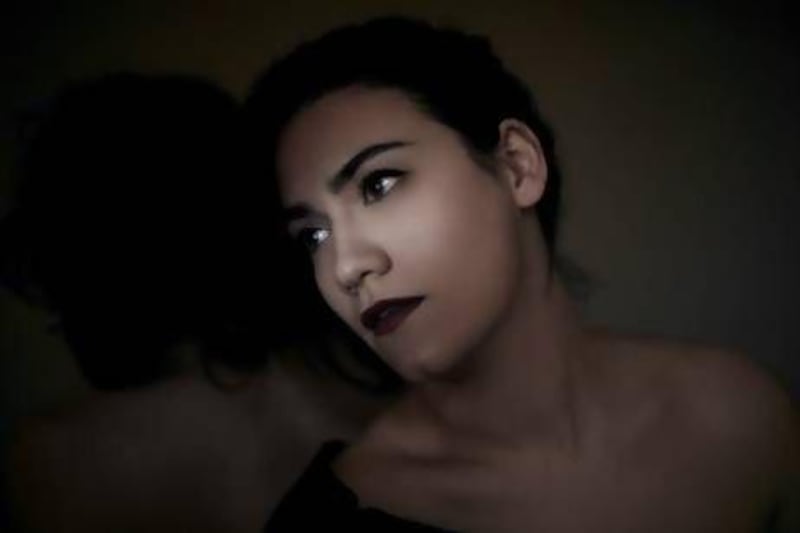Raised in the north of England by a Norwegian mother and Pakistani father, Nadine Shah’s first singing gig was at a local theme park when she was 13. Her recently released debut album is dark but intoxicating, Nick Levine reports
Nadine Shah has named her debut album Love Your Dum and Mad: a spoonerism, or play on words. It's an amusing title but feels like a strange fit for Shah's music, which is filled with enough dark drama to be attracting some pretty lofty comparisons. Shah's name keeps being mentioned in the same breath as Nick Cave and PJ Harvey - "in my opinion, two of the greatest artists of all time," says Shah - but her music has a character all of its own: it's intoxicating and sometimes spooky, but always feels very human. On the album, Shah sings about lost youth, marriage breakdown and mental illness in a remarkable voice that's as rich and intense as an espresso shot.
"Dark stories just always seem more poignant to me," Shah explains when we meet for coffee near her flat in east London. "My favourite films are always about a woman dying, or a massive political injustice or someone overcoming a struggle. It's those dark stories that really stick with me and make me want to sit down and write a song."
Despite her fondness for all things Gothic, in person Shah turns out to be chatty and cheerful. She even admits her album "isn't necessarily the sort of music I listen to - I mean, the Pointer Sisters are one of my favourite bands."
So, is songwriting an outlet for her sinister side? "Oh, of course," says Shah. "Like everyone who seems perfectly happy, I have hang-ups and other stuff going on under the surface. But it's only when I start talking about my songs that I realise they're an outlet, which means some interviews can feel like therapy."
Shah, 25, was born to a Norwegian mother and Pakistani father and raised in the north of England, where her father runs a successful curtain business. She had a powerful voice even as a child and attended musical theatre classes at weekends before landing her first singing job - performing pop songs at a local theme park - when she was 13.
Three years later, Shah travelled down to London to audition for West End musicals, but found she was younger and less experienced than her rivals and failed to stand out. For a while, she studied at art school and then considered working in television or as a documentary photographer. "I wanted to be a singer, but I never thought I could make the sort of music I wanted to make and have a career out of it," she tells me.
Shah's dreams of a singing career only really started to look realistic around three years ago, when she teamed up with Ben Hillier, a well-respected British music producer whose CV includes albums by Blur and Depeche Mode. Remarkably, Hillier agreed to work with Shah after hearing just one song. The pair hit it off at their very first coffee meeting, though Shah admits she wasn't entirely honest with her future collaborator.
"I told him I had loads of songs but at that point I'd only written the one," she confesses. "We just got on really well though, and had really similar ideas about the sort of music we wanted to make."
In fact, the duo were so in tune that Hillier's role expanded beyond that of a traditional producer, and Shah describes the finished album as a collaboration. She would record basic demos on her laptop, just vocal and piano lines, before taking the embryonic songs to Hillier.
"Then Ben would say, 'that's disgusting!'" Shah chuckles. "He'd say, 'let's put a bass line on it', 'let's get rid of that high note', 'let's put some fuzz on the vocal' …". Shah admits there were times when she'd be sat in the studio wondering if Hillier's additions were sounding a little too weird, but over time she learnt to trust his judgement and, though some songs were altered more than others, the end result was "always really great". Shah is proud to have made her album with just one producer - unlike some of her contemporaries, who take a pick-and-mix approach. "Surely an album should be a cohesive piece of work," Shah argues. "I think Adele's very talented, but I don't like her album. It's not an album, it's a collection of singles. You've got [producer] Paul Epworth on this track, [producer] Rick Rubin on that one, and it feels like they're just ticking boxes. Have we got a jazz song? A blues song? Have we got a slow one? A fast one? It's schizophrenic, and there are so many albums like that."
Love Your Dum and Mad is cohesive, but it's also an album of two halves. The first half was recorded in Hillier's south London studio and features backing from a full band of musicians: Shah describes these songs as more dense. In contrast, the songs on the second half tend to be sparer-sounding and were recorded in the curtain warehouse belonging to Shah's father.
"We wanted to hire a warehouse in London but it was too expensive," Shah recalls. "So Ben said, 'Doesn't your dad have a warehouse?'. It's a huge room filled with rows and rows of fabric and ready-made curtains, and Ben put up microphones everywhere so you get a real sense of space on the recordings.
"I think if we'd recorded those songs in the studio, they would have sounded too clean and pretty. Recording them in the warehouse with all its weird noises made them creepier, which is in keeping with the [album's] first half."
Did Shah's father like the music she was making? "No, he thought it was really miserable! He'd make suggestions like: 'Maybe you should put a big string section on that song - like Celine Dion'."
Miserable isn't quite the right word for Love Your Dum and Mad. It's certainly not a sunny album, but neither is it depressing. Shah's songs have a gloomy beauty to them and the best ones contain lyrics that really resonate.
One standout track, To Be a Young Man, was inspired by a memorable conversation with an ageing beatnik Shah encountered in a public house. When Shah sings "you don't know what I would give to be a young man again", she conveys all his longing and weariness in a single line. Another highlight called Runaway captures a woman's very modern attitude towards marriage breakdown. "I've the right to half this house - I'm fine," Shah sings, adopting the role of a wife who's caught her husband cheating.
According to Shah, the album has no recurring theme and instead documents the last four years of her life. During this period, two of her close friends committed suicide and the singer addresses their respective battles with mental health problems on four songs: Used It All, Remember, Dreary Town and Floating - Shah's personal favourite.
One of these friends was a painter and it's his work that graces the album's cover. Unwittingly, he also gave the album its title, which turns out to be a better fit than it initially seems.
"He called one of his paintings Love Your Dum and Mad and it really made me laugh, I just thought it was brilliant," Shah recalls. "I put it into a lyric on Floating, and then I thought, given some of the things I've written about, it was perfectly apt to use it for the album title too."
Nick Levine is a freelance music journalist based in London.





